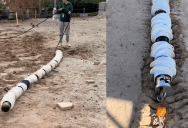Meet The Snake Robot That NASA Hopes Will Help Explore Saturn’s Moon

Robotics are making waves in many technical and healthcare spaces on Earth, freeing up doctors and nurses who need an extra pair of hands or a second eye for diagnoses.
Obviously, the Mars Rover and others like it have been helping us explore space, too.
Now, NASA hopes this snake prototype will be able to deftly navigate Saturn’s moon Enceladus in search of possible life.
Called the Exobiology Extant Life Surveyor (EELS), the robot is over 14 feet long and is self-propelled, capable of autonomously trekking through oceans, sands, rocks, and cliffs.
This is thanks to its flexible body and articulated segments.

An article recently published in Science Robots says the focus will be on the robot going through vents in Enceladus’s icy crust and navigating into the subsurface oceans.
“There is substantial uncertainty with respect to its geometry and the physical properties.”
EELS needs to be mobile, sure, but it also needs to be smart. Its “head” will come equipped with an array of sensors and optical cameras, including light detection and ranging, stereo cameras, and a barometer.

The goal is for the robot to be able to make its own decisions and to be “risk aware” as it navigates the various terrains on its own.
“We have been using glaciers as Earth analog ice environments to develop and test its architecture as a stepping stone toward Enceladus.”

NASA wants to explore Enceladus because the data brought back by the Cassini probe indicated the existence of subsurface oceans. Many of the moons have oceans, but the Enceladus has also been identified as having the conditions necessary for life.
The snake-like robot should be able to navigate all of the surfaces with relative ease, and will also be able to resist the water plumes that burst upward at regular intervals as well.
We might get to see it tested out in Antarctica before it heads into space.
Which will also be pretty cool to see.

Sign up to get our BEST stories of the week straight to your inbox.




